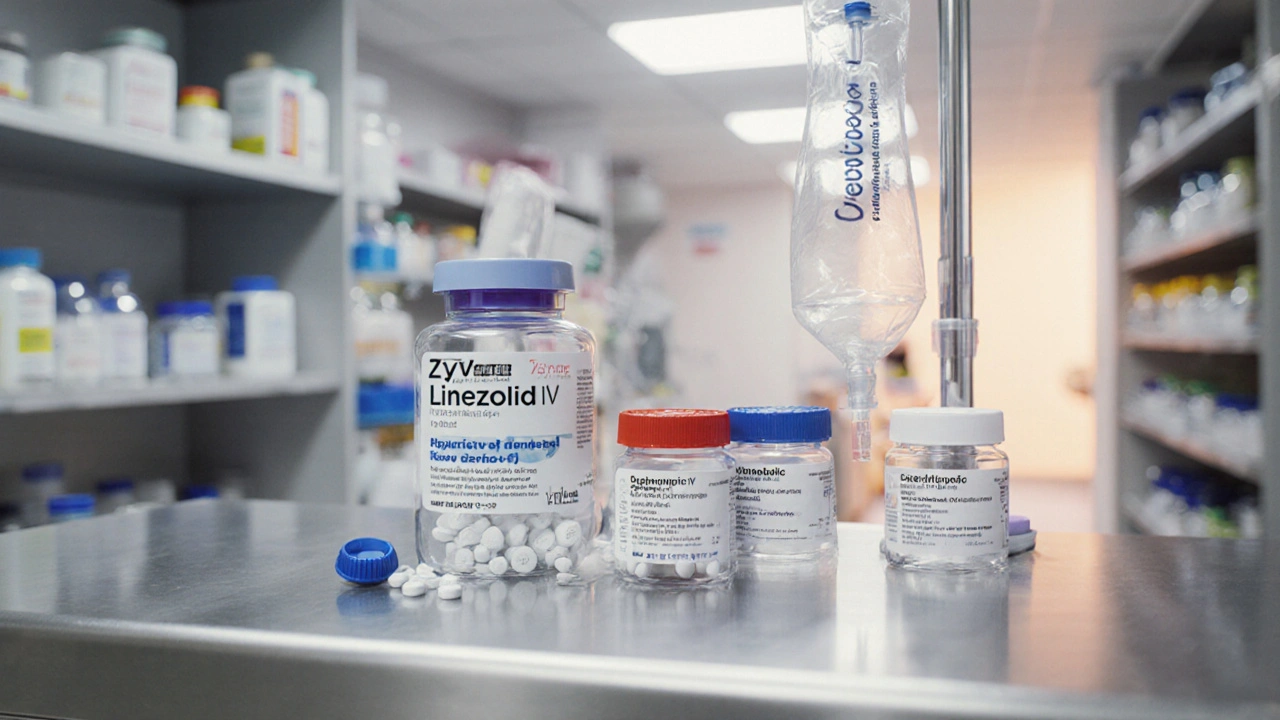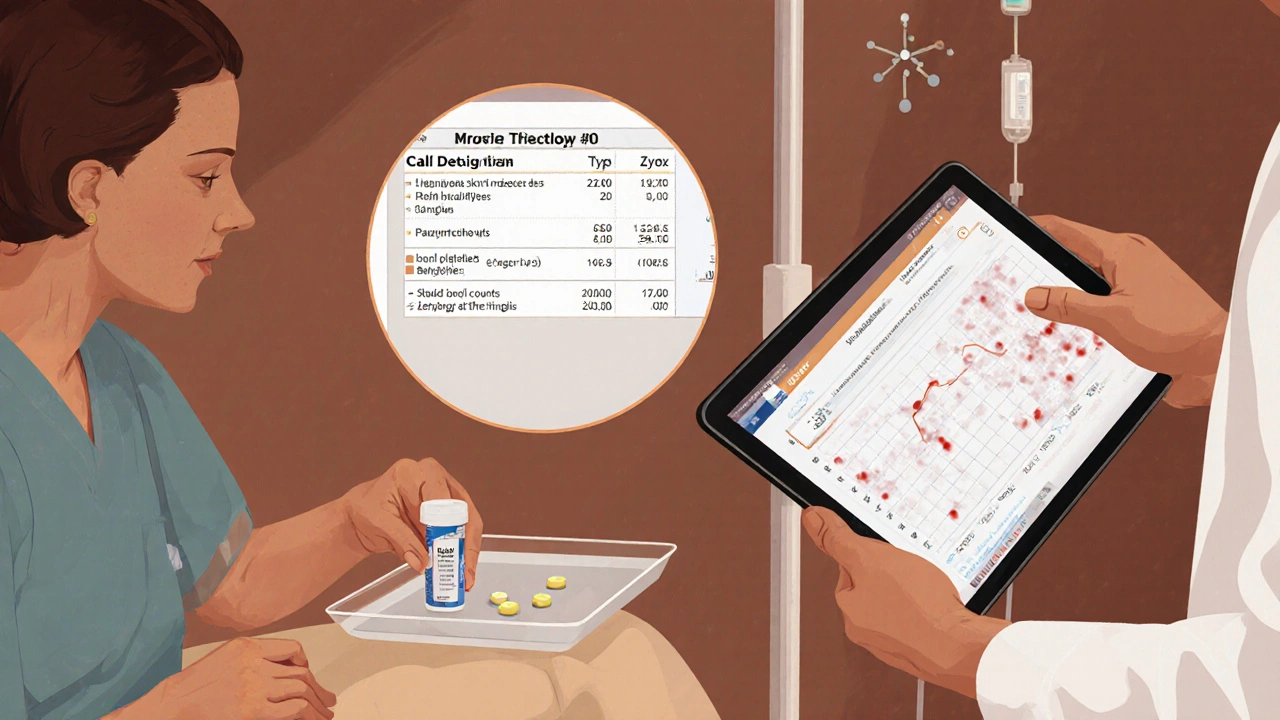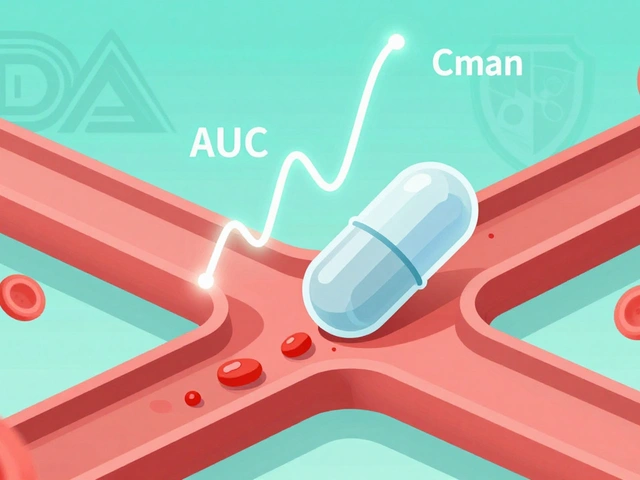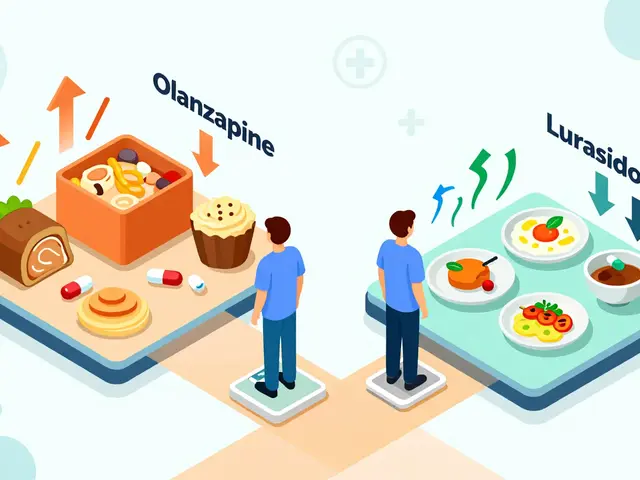Zyvox (Linezolid) vs Alternative Antibiotics: A Detailed Comparison

Zyvox vs Alternative Antibiotics Comparison Tool
Select two antibiotics and click "Compare" to see detailed comparison
Zyvox (Linezolid)
- Spectrum: MRSA, VRE, MDR-TB, Streptococcus spp.
- Dosing: IV 600 mg q12h or PO 600 mg BID
- Safety: Myelosuppression, serotonin syndrome, neuropathy
- Cost: ~$120/day (IV) / $150/oral
Tedizolid
- Spectrum: MRSA, VRE (similar to Linezolid)
- Dosing: IV/PO 200 mg QD
- Safety: Lower thrombocytopenia risk, mild GI upset
- Cost: ~$80/day (IV/PO)
Daptomycin
- Spectrum: MRSA, VRE (bactericidal), no Gram-negatives
- Dosing: IV 4–6 mg/kg QD
- Safety: Myopathy (CK rise), allergic reactions
- Cost: ~$70/day (IV)
Vancomycin
- Spectrum: MRSA, MSSA, Enterococci (no VRE)
- Dosing: IV 15–20 mg/kg q12h (dose-adjusted)
- Safety: Nephrotoxicity, red-man syndrome, ototoxicity
- Cost: ~$30/day (generic) + monitoring costs
Ceftaroline
- Spectrum: MRSA, MSSA, H. influenzae, Klebsiella spp.
- Dosing: IV 600 mg q12h
- Safety: Diarrhea, C. difficile risk low
- Cost: ~$55/day (IV)
Key Takeaways
- Zyvox (Linezolid) offers convenient oral dosing but carries a higher risk of hematologic toxicity with prolonged use.
- Tedizolid provides a similar spectrum with fewer drug‑drug interactions and a shorter treatment course.
- Daptomycin is the go‑to option for bloodstream infections and can be dosed once daily, but it cannot be used for pneumonia.
- Vancomycin remains a workhorse for MRSA but demands therapeutic drug monitoring and renal dose adjustments.
- Ceftaroline and delafloxacin broaden coverage to include some gram‑negative organisms while retaining activity against resistant staphylococci.
When clinicians face a serious gram‑positive infection, the choice of antibiotic can dramatically affect outcomes, length of hospital stay, and overall cost. Zyvox (Linezolid) is an oral and intravenous oxazolidinone antibiotic that targets resistant bacteria such as MRSA and VRE. Its dual formulation makes it attractive for step‑down therapy, yet concerns about serotonin syndrome, peripheral neuropathy, and myelosuppression keep prescribers cautious. This article breaks down how Zyvox stacks up against the most common alternatives, using real‑world data and practical dosing considerations so you can match the right drug to the right patient.
What Makes Zyvox (Linezolid) Unique?
Zyvox belongs to the oxazolidinone class, a relatively new family of synthetic antibiotics first approved in 2000. Its mechanism centers on binding to the 50S ribosomal subunit, halting protein synthesis in gram‑positive bacteria. Because it penetrates lung tissue and bone well, it’s approved for hospital‑acquired and ventilator‑associated pneumonia, as well as complicated skin and soft‑tissue infections.
Key attributes:
- Formulations: 600mg IV every 12h or 600mg oral twice daily.
- Spectrum: Strong activity against MRSA, VRE, penicillin‑resistant Streptococcus pneumoniae, and some atypical pathogens.
- Pharmacokinetics: 100% bioavailability, making IV‑to‑oral switch seamless.
- Safety signals: Thrombocytopenia, anemia, serotonin syndrome when combined with serotonergic agents, and neuropathy with >28days of therapy.
Because of these characteristics, Zyvox is often reserved for infections where oral therapy is needed early, or when other agents are contraindicated.

Alternative Antibiotics Worth Considering
Below are the six most frequently compared agents, each introduced with microdata for easy indexing.
Tedizolid is a newer oxazolidinone that shares the same ribosomal target but offers a once‑daily 200mg dose and a generally better safety profile, especially regarding myelosuppression.
Daptomycin is a cyclic lipopeptide that disrupts bacterial cell‑membrane potential. It’s bactericidal, given once daily (4-6mg/kg), and works well for bloodstream and right‑sided endocarditis, though it’s inactivated by pulmonary surfactant and thus unsuitable for pneumonia.
Vancomycin is a glycopeptide that interferes with cell‑wall synthesis. It’s the historic “gold standard” for MRSA, administered IV with dose adjustments based on trough levels (15-20µg/mL) and renal function.
Ceftaroline is a fifth‑generation cephalosporin that binds PBP2a, giving it activity against MRSA while retaining broad gram‑negative coverage. Typical dosing is 600mg IV every 12h.
Delafloxacin is a fluoroquinolone with enhanced activity in acidic environments, making it useful for skin infections and some respiratory isolates, including MRSA. It’s dosed 300mg IV or oral every 12h.
How We Compare the Options
To keep the comparison practical, we focus on six decision‑critical criteria:
- Spectrum of activity - which pathogens are reliably covered?
- Route & dosing convenience - IV only, oral availability, frequency.
- Safety & tolerability - hematologic, renal, neurologic, drug‑drug interaction risk.
- Resistance potential - likelihood of emerging resistance during therapy.
- Cost & formulary impact - acquisition cost, need for monitoring, hospital stay implications.
- Special patient considerations - renal/hepatic impairment, pregnancy, outpatient eligibility.
The table below condenses these data points for quick reference.
| Attribute | Zyvox (Linezolid) | Tedizolid | Daptomycin | Vancomycin | Ceftaroline | Delafloxacin |
|---|---|---|---|---|---|---|
| Spectrum (key pathogens) | MRSA, VRE, MDR‑TB, Streptococcus spp. | MRSA, VRE (similar to Linezolid) | MRSA, VRE (bactericidal), no Gram‑negatives | MRSA, MSSA, Enterococci (no VRE) | MRSA, MSSA, H. influenzae, Klebsiella spp. | MRSA, MSSA, Pseudomonas spp., atypicals |
| Route & Dosing | IV 600mg q12h or PO 600mg BID | IV/PO 200mg QD | IV 4-6mg/kg QD | IV 15-20mg/kg q12h (dose‑adjusted) | IV 600mg q12h | IV/PO 300mg q12h |
| Key Safety Issues | Myelosuppression, serotonin syndrome, neuropathy | Lower thrombocytopenia risk, mild GI upset | Myopathy (CK rise), allergic reactions | Nephrotoxicity, red‑man syndrome, ototoxicity | Diarrhea, C. difficile risk low | Tendinitis, QT prolongation (rare) |
| Resistance Concerns | Rare linezolid‑resistant MRSA (cfr gene) | Low, but cross‑resistance possible | Rare daptomycin‑non‑susceptible strains | VRSA emerging; requires MIC monitoring | Low; beta‑lactamase stability | Fluoroquinolone resistance mechanisms |
| Cost (US2025) | ~$120 per day (IV) / $150 oral | ~$80 per day (IV/PO) | ~$70 per day (IV) | ~$30 per day (generic) + monitoring costs | ~$55 per day (IV) | ~$65 per day (IV/PO) |
| Renal/ Hepatic Adjustments | No adjustment needed | No adjustment needed | Dose reduced if CrCl <30ml/min | Dose reduced if CrCl <50ml/min | No adjustment needed | No adjustment needed |
Choosing the Right Drug for Specific Clinical Scenarios
Skin and soft‑tissue infections (SSTI): If the patient is stable enough for oral therapy, Zyvox’s 100% bioavailability makes it a solid pick, especially when MRSA is confirmed. Tedizolid can cut treatment length to six days versus the typical ten for Zyvox, and it carries a lower platelet‑drop risk, making it preferable for patients with baseline thrombocytopenia.
Hospital‑acquired pneumonia (HAP) / VAP: Both Zyvox and Ceftaroline penetrate lung tissue well. However, Daptomycin is off‑label because surfactant neutralizes its activity. Vancomycin remains an option but requires careful trough monitoring and can cause renal issues, which is a concern in critically ill patients.
Bloodstream infections (BSI) and endocarditis: Daptomycin’s rapid bactericidal action and once‑daily dosing make it the first‑line oxazolidinone‑alternative for MRSA BSI, provided there’s no pulmonary involvement. If the isolate is daptomycin‑non‑susceptible, Zyvox can be used as a salvage agent, though the longer time to sterilize blood cultures should be weighed.
Patients with renal impairment: Zyvox and Tedizolid require no dose adjustment, giving them an edge over vancomycin and daptomycin, which need significant renal dosing changes. Ceftaroline also avoids renal dosing tweaks, but its cost is a bit higher than generic vancomycin.
Outpatient parenteral antimicrobial therapy (OPAT): Oral Zyvox allows a seamless switch from IV, reducing line‑related complications. Tedizolid’s once‑daily oral regimen is equally convenient, but its shorter course reduces total antibiotic exposure. For patients who cannot tolerate oral meds, daptomycin’s once‑daily IV schedule fits OPAT well.
Practical Tips & Pitfalls to Avoid
- Always review the patient’s medication list for serotonergic agents before starting Zyvox. Discontinuing or switching to an alternative like Tedizolid can avert serotonin syndrome.
- Monitor platelet counts at baseline, then weekly if therapy exceeds two weeks. Drop below 50×10⁹/L? Consider switching.
- For daptomycin, obtain a baseline creatine kinase (CK) level and repeat if the patient reports muscle pain.
- Vancomycin troughs should be drawn 30minutes before the fourth dose; failing to do so leads to sub‑therapeutic dosing and resistance.
- Ceftaroline requires adjustment for severe hepatic impairment (Child‑Pugh C); otherwise, dose remains standard.
- Delafloxacin’s QT effect is modest, but avoid co‑administration with other QT‑prolonging drugs in patients with known arrhythmias.
Bottom Line
There’s no one‑size‑fits‑all answer. Zyvox shines when you need a reliable oral step‑down option for MRSA or VRE, but its hematologic side‑effects and cost keep it off the first‑line list for many institutions. Tedizolid offers a newer, safer profile for short courses, while daptomycin and vancomycin remain the backbone for serious bloodstream infections and renal‑adjusted dosing, respectively. Ceftaroline and delafloxacin broaden the spectrum to include gram‑negative organisms, making them valuable when mixed flora are suspected.
Use the comparison table as a quick reference, then match the drug to the patient’s infection type, comorbidities, and care setting. This approach maximizes efficacy, minimizes toxicity, and helps control pharmacy spend.
Frequently Asked Questions
Can Zyvox be used for tuberculosis?
Yes. Linezolid (Zyvox) is one of the few oral agents active against multidrug‑resistant TB, but it’s reserved for cases where first‑line drugs fail because of the long‑term toxicity risk.
Is Tedizolid approved for outpatient use?
Tedizolid is FDA‑approved for acute bacterial skin and skin‑structure infections and can be given orally, making it suitable for outpatient therapy after an initial IV dose.
Why can’t daptomycin treat pneumonia?
Pulmonary surfactant inactivates daptomycin, neutralizing its bactericidal activity. Hence guidelines list it as contraindicated for lung infections.
How frequently should I check labs while a patient is on Zyvox?
Baseline CBC, then weekly CBC for courses longer than two weeks. Also monitor liver enzymes if the patient has hepatic disease.
Is vancomycin still cost‑effective compared to newer agents?
Vancomycin’s generic price is low, but the need for therapeutic drug monitoring, potential nephrotoxicity, and longer hospital stays can offset the drug cost. Newer agents may be cheaper overall when considering total care costs.






Comments (18)
Justin Ornellas
10 Oct 2025
The pharmacokinetic profile of linezolid is unequivocally superior when oral step‑down therapy is contemplated, owing to its 100 % bioavailability. Moreover, the drug’s ability to achieve steady‑state concentrations in pulmonary tissue surpasses that of many beta‑lactams, which rationalizes its indication for ventilator‑associated pneumonia. Nevertheless, the haematologic toxicity-particularly thrombocytopenia after the third week of therapy-necessitates vigilant complete blood‑count monitoring, lest clinicians overlook a silent danger. In contrast, tedizolid, albeit a newer oxazolidinone, administers a once‑daily 200 mg regimen, thereby enhancing adherence while diminishing platelet suppression. Daptomycin’s bactericidal mechanism, mediated by membrane depolarization, confers an advantage in bloodstream infections but precludes its use in pulmonary settings because pulmonary surfactant abrogates its activity. Vancomycin, the historic workhorse, remains cost‑effective yet imposes nephrotoxicity and the infamous red‑man phenomenon, mandating therapeutic drug monitoring. Ceftaroline distinguishes itself by binding PBP2a, granting it activity against MRSA while retaining gram‑negative coverage, a duality that can obviate combination therapy in certain cellulitis cases. Delafloxacin’s acid‑stable fluoroquinolone scaffold permits enhanced intracellular penetration, rendering it useful for skin and soft‑tissue infections in acidic microenvironments. From an economic perspective, linezolid’s daily acquisition cost exceeds $120 intravenously and $150 orally, a figure that dwarfs vancomycin’s sub‑$30 price tag but may be offset by shortened hospital stays when oral therapy is feasible. The propensity for serotonin syndrome when linezolid is co‑administered with selective serotonin reuptake inhibitors demands a thorough medication reconciliation, a detail often omitted in hurried discharge summaries. Resistance mechanisms, such as the cfr methyltransferase gene, remain rare but herald a potential future where linezolid efficacy could be compromised, underscoring the need for antimicrobial stewardship. The clinical decision matrix, therefore, must weigh spectrum, route, safety, resistance potential, and cost in a patient‑centred fashion rather than defaulting to familiarity. For immunocompromised hosts with prolonged infections, the cumulative haematologic risk of linezolid may outweigh its convenience, steering therapy toward daptomycin or ceftaroline. Conversely, in outpatient settings where intravenous access is a barrier, linezolid’s oral formulation becomes a decisive factor, provided the clinician monitors platelet counts weekly. Ultimately, the choice of agent is a microcosm of the broader tension between efficacy, safety, and economics that defines modern antimicrobial therapy.
JOJO Yang
10 Oct 2025
i cant beleive they even think linezolid is cheap!
Faith Leach
11 Oct 2025
The pharma giants hide the true cost of linezolid behind insurance tricks, and the government silently approves it to keep us dependent. Every time a new oxazolidinone hits the market, they pump it through a pipeline of lobbyists. It's not a coincidence that the same corporations own the hospitals where these drugs are stocked. Remember, the real cure is keeping the populace scared of infection so they never question the supply chain.
Eric Appiah Tano
12 Oct 2025
Great breakdown of the key points, Eric. I especially appreciate the emphasis on renal dosing for vancomycin; many clinicians overlook that detail. Highlighting the oral bioavailability of linezolid really helps when planning discharge. Your balanced tone makes it easy for trainees to follow. Keep sharing these practical pearls!
Jonathan Lindsey
13 Oct 2025
While the preceding exposition is exhaustive, let us not lose sight of the pragmatic reality that clinicians often prioritize formulary availability over pharmacologic elegance. The cost differential, albeit substantial, is frequently mitigated by institutional contracts that obscure true expense. Moreover, the sociopolitical impetus to curb antimicrobial resistance supersedes individual patient convenience in many policy frameworks. Thus, the decision matrix you present, though academically sound, must be tempered by the fiscal constraints of the health system. In practice, the clinician’s pen is as bound by budgetary policy as by microbiologic data. Consequently, the optimal agent may simply be the one that the pharmacy can dispense without a prior authorization delay.
Gary Giang
14 Oct 2025
Linezolid’s pharmacology is fascinating; its 100 % oral bioavailability is a rare trait among antibiotics. Yet the myelosuppression risk keeps me cautious.
steve wowiling
15 Oct 2025
Honestly, the conspiracy angle is a stretch, but you raise a point about insurance opacity. Still, most prescribers base choices on clinical data, not hidden agendas. The drug’s safety profile is what really matters.
Warren Workman
16 Oct 2025
From a mechanistic standpoint, linezolid’s ribosomal binding affinity confers a static effect, whereas daptomycin’s depolarization yields bactericidal activity-a distinction clinicians must internalize. The kinetic parameters, such as AUC/MIC ratios, further differentiate therapeutic windows. In resistant phenotypes, cross‑resistance via the cfr gene underscores the evolutionary pressure exerted by widespread oxazolidinone use.
king singh
17 Oct 2025
I agree with the emphasis on cost-effectiveness; formulary committees should weigh these factors. Collaboration leads to better stewardship.
Adam Martin
18 Oct 2025
Your jargon-laden deep dive is impressive, yet many bedside physicians need a digestible summary. In plain English, linezolid works well for oral step‑down, but watch the blood counts. Daptomycin is great for bloodstream infections, but not for lungs. So the choice boils down to infection site, safety, and logistics. That’s the practical takeaway.
Ryan Torres
19 Oct 2025
💊 Linezolid is a solid option when you need oral coverage, but keep an eye on platelets! 👍
shashi Shekhar
20 Oct 2025
Sure, because monitoring vancomycin levels is a breeze, right? Maybe if you enjoy endless lab draws. Sarcasm aside, the monitoring burden does increase overall cost.
Marcia Bailey
21 Oct 2025
Exactly, the oral option is a game‑changer 😊. Just don’t forget the CBC checks!
Hannah Tran
22 Oct 2025
Your point about step‑down therapy aligns with outpatient management goals. It reduces hospital length of stay and improves patient comfort. Thanks for highlighting that.
Dhananjay Sampath
22 Oct 2025
In reviewing the data, one observes a clear trade‑off: efficacy versus toxicity; cost versus convenience; oral versus intravenous-each factor interplays with the others, necessitating a holistic assessment; therefore, prescribers must integrate pharmacodynamics, patient comorbidities, and institutional policies into a cohesive therapeutic plan.
kunal ember
23 Oct 2025
The comparative table you presented serves as a microcosm of antimicrobial decision‑making, encapsulating not merely numerical values but also clinical nuances that cannot be reduced to a single column. For instance, the spectrum row delineates the breadth of pathogen coverage, yet the clinician must also consider local antibiograms, which may shift the perceived superiority of one agent over another. Dosing frequency, as illustrated, influences adherence, especially in outpatient settings where a once‑daily regimen can dramatically improve compliance compared to a twice‑daily schedule. Safety profiles, while succinctly listed, require deeper interpretation; myelosuppression associated with linezolid may be acceptable in a short course but becomes prohibitive in prolonged therapy. Cost, though quantified, should be contextualized within the total cost of care, accounting for monitoring expenses and potential adverse event management. Ultimately, the table is a tool, not a prescription, and its optimal use demands clinician judgment tempered by patient‑specific variables.
Kelly Aparecida Bhering da Silva
24 Oct 2025
America deserves the best antibiotics, and linezolid is a prime example of our pharmaceutical prowess. No foreign interference should dictate how we treat our soldiers or citizens. Proudly we stand behind domestically produced therapeutics.
Michelle Dela Merced
25 Oct 2025
Drama queen vibes: linezolid is the Beyoncé of antibiotics, flawless yet demanding! 🎤💅